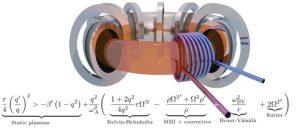The extremely hot plasma inside a tokamak nuclear fusion reactor ‘floats’ in a magnetic field to avoid contact with the walls. Plasma rotation has several different effects on the plasma stability, succinctly summarized in a comprehensive analytical stability criterion derived in the following publication:
![]() Stability of localized modes in rotating tokamak plasmas
Stability of localized modes in rotating tokamak plasmas
J. W. Haverkort and H. J. de Blank. Plasma Physics and Controlled Fusion, vol. 53, nr. 4, p. 045008. © 2011 DOI: 10.1088/0741-3335/53/4/045008

Besides well-known terms arising from the Kelvin-Helmholtz, magneto-rotational, and Rayleigh-Taylor instabilities, the criterion also contains two stabilizing terms due to rotation. One was described in an earlier post. Another less known effect was discovered to be due the Coriolis force also responsible for the circulating weather patterns in the earth atmosphere.
For certain conditions (See Eq. 3) the stabilizing influence of flow shear outweighs other destabilizing effects, allowing differential rotation to have a positive effect on tokamak stability.
![]() Flow shear stabilization of rotating plasmas due to the Coriolis effect
Flow shear stabilization of rotating plasmas due to the Coriolis effect
J. W. Haverkort and H. J. de Blank. Physical Review E, vol. 86, 016411. © 2012 The American Physical Society DOI: 10.1103/PhysRevE.86.016411



